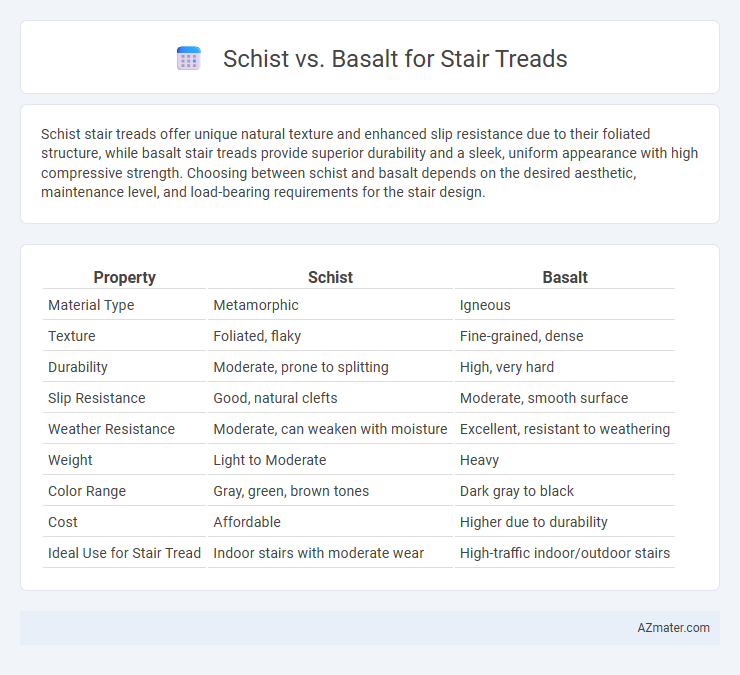Schist stair treads offer unique natural texture and enhanced slip resistance due to their foliated structure, while basalt stair treads provide superior durability and a sleek, uniform appearance with high compressive strength. Choosing between schist and basalt depends on the desired aesthetic, maintenance level, and load-bearing requirements for the stair design.
Table of Comparison
| Property | Schist | Basalt |
|---|---|---|
| Material Type | Metamorphic | Igneous |
| Texture | Foliated, flaky | Fine-grained, dense |
| Durability | Moderate, prone to splitting | High, very hard |
| Slip Resistance | Good, natural clefts | Moderate, smooth surface |
| Weather Resistance | Moderate, can weaken with moisture | Excellent, resistant to weathering |
| Weight | Light to Moderate | Heavy |
| Color Range | Gray, green, brown tones | Dark gray to black |
| Cost | Affordable | Higher due to durability |
| Ideal Use for Stair Tread | Indoor stairs with moderate wear | High-traffic indoor/outdoor stairs |
Introduction to Schist and Basalt Stone
Schist is a metamorphic rock characterized by its foliated texture and abundant mica minerals, offering a visually appealing, layered appearance ideal for stair treads requiring both durability and aesthetic appeal. Basalt, an extrusive igneous rock formed from rapid cooling of lava, is dense, fine-grained, and highly resistant to abrasion, making it a robust choice for heavy-traffic stair surfaces. Both stones provide durability, but schist's unique mineral alignment contrasts with basalt's uniform hardness and industrial resilience.
Geological Formation of Schist vs Basalt
Schist forms through regional metamorphism, where intense heat and pressure transform sedimentary or igneous rocks into a foliated texture characterized by aligned mica minerals. Basalt originates from rapid cooling of low-viscosity lava at the Earth's surface, producing a fine-grained, dense volcanic rock. The foliated structure of schist contrasts sharply with the massive, homogenous nature of basalt, influencing their durability and slip resistance when used as stair treads.
Physical Properties Comparison
Schist stair treads exhibit higher porosity and lower density compared to basalt, resulting in moderate durability but increased water absorption. Basalt offers superior hardness and compressive strength, making it more resistant to abrasion and suitable for high-traffic staircases. Thermal conductivity of basalt exceeds schist, contributing to better heat retention and slip resistance in stair tread applications.
Durability and Weather Resistance
Schist offers excellent durability with its foliated texture, providing strong resistance to wear and impact, making it suitable for stair treads in high-traffic areas. Basalt, an igneous rock with a dense, fine-grained structure, excels in weather resistance, showing superior performance against frost, moisture, and UV exposure. Both materials are robust choices, but basalt's low porosity and hardness give it a slight advantage in long-term outdoor durability and weather resilience.
Aesthetic Differences for Stair Treads
Schist offers a textured, layered appearance with natural shimmer due to its mica content, creating a rustic and elegant look for stair treads. Basalt provides a smooth, dense, and uniform dark gray to black surface, delivering a modern and sleek aesthetic. The choice between schist and basalt for stair treads depends on whether a warm, organic texture or a minimalist, contemporary style is desired.
Slip Resistance and Safety
Schist stair treads offer superior slip resistance due to their naturally rough and uneven surface texture, making them safer for high-traffic areas prone to moisture. Basalt, with its dense, fine-grained composition, provides moderate slip resistance but can become slippery when polished or wet. Prioritizing schist for stair treads enhances pedestrian safety by minimizing slip hazards in both indoor and outdoor environments.
Installation and Maintenance Considerations
Schist stair treads require careful sealing and regular maintenance to prevent moisture penetration and preserve their natural sheen, while basalt offers superior durability with minimal upkeep due to its dense, non-porous structure. Installation of schist demands precise cutting and leveling to accommodate its layered texture, whereas basalt's uniform hardness allows for straightforward cutting and a more stable, even surface. Both materials benefit from professional installation to ensure longevity, but basalt's resistance to chipping and weathering makes it particularly suited for high-traffic or outdoor stair applications.
Cost Analysis: Schist vs Basalt
Schist stair treads typically cost between $15 and $25 per square foot due to their unique foliated texture and aesthetic appeal, while basalt ranges from $10 to $20 per square foot, offering a more budget-friendly option with high durability. Installation costs for both materials are similar, averaging around $8 to $12 per square foot, but basalt's uniform density often reduces labor time and total expenses. Maintenance expenses are lower for basalt because of its resistance to weathering and staining, whereas schist may require more frequent sealing to preserve its appearance over time.
Environmental Impact and Sustainability
Schist stair treads, composed primarily of metamorphic minerals, offer exceptional durability with minimal quarrying impact, contributing to reduced environmental degradation compared to more energy-intensive materials. Basalt, a volcanic igneous rock, boasts high compressive strength and weather resistance, but its extraction and processing involve significant carbon emissions due to quarrying and transportation. Choosing schist promotes sustainability through lower embodied energy and better lifecycle environmental performance, while basalt provides longevity that can offset initial environmental costs over extended use.
Choosing the Best Stone for Stair Treads
Schist offers a unique textured surface with natural slip resistance, making it ideal for stair treads in both indoor and outdoor settings. Basalt provides exceptional durability and a sleek, modern appearance, well-suited for high-traffic areas requiring strong wear resistance. When choosing the best stone for stair treads, prioritize factors such as slip resistance, maintenance level, aesthetic preferences, and exposure to weather conditions.

Infographic: Schist vs Basalt for Stair Tread
 azmater.com
azmater.com